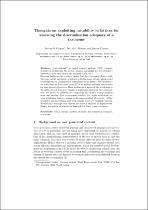 ResearchSpace
ResearchSpace
Thoughts on exploiting instability in lattices for assessing the discrimination adequacy of a taxonomy
JavaScript is disabled for your browser. Some features of this site may not work without it.
- ResearchSpace
- →
- Research Publications/Outputs
- →
- Conference Publications
- →
- View Item
| dc.contributor.author |
Cooper, Antony K

|
|
| dc.contributor.author |
Kourie, DG

|
|
| dc.contributor.author |
Coetzee, S

|
|
| dc.date.accessioned | 2010-11-05T08:28:08Z | |
| dc.date.available | 2010-11-05T08:28:08Z | |
| dc.date.issued | 2010-10 | |
| dc.identifier.citation | Cooper, AK, Kourie, DG and Coetzee, S. 2010. Thoughts on exploiting instability in lattices for assessing the discrimination adequacy of a taxonomy. Concept Lattices and Their Applications (CLA 2010), Seville, Spain, 19-21 October 2010, pp 12 | en |
| dc.identifier.isbn | 978-84614-4027-6 | |
| dc.identifier.uri | http://hdl.handle.net/10204/4525 | |
| dc.description | Concept Lattices and Their Applications (CLA 2010), Seville, Spain, 19-21 October 2010 | en |
| dc.description.abstract | Conventionally in formal concept analysis (FCA), concept stability is preferred in the lattice, because instability (i.e. low stability) represents noise that clouds the analysis of the data. However, high concept stability means that there are many objects with the same intent and many attributes with the same extent, which could be interpreted as a high level of redundancy in the lattice. We report here on work that we have done using FCA to analyse different taxonomies for user-generated content. Here, redundancy amongst the attributes in the lattice is not desirable, because it represents classes in the taxonomy that are unable to differentiate adequately the objects being classified from one another. Low extensional stability (i.e. noisy attributes) reveals attributes that are unique to the associated set of objects — if the attributes are interesting, they could imply there are “missing” objects. Redundancy amongst the objects can have a number of implications. Hence, instability in a lattice is desirable for some types of analysis. | en |
| dc.language.iso | en | en |
| dc.relation.ispartofseries | Conference Paper | en |
| dc.subject | Formal concept analysis | en |
| dc.subject | Discrimination adequacy | en |
| dc.subject | Taxonomy | en |
| dc.subject | Lattices | en |
| dc.title | Thoughts on exploiting instability in lattices for assessing the discrimination adequacy of a taxonomy | en |
| dc.type | Conference Presentation | en |
| dc.identifier.apacitation | Cooper, A. K., Kourie, D., & Coetzee, S. (2010). Thoughts on exploiting instability in lattices for assessing the discrimination adequacy of a taxonomy. http://hdl.handle.net/10204/4525 | en_ZA |
| dc.identifier.chicagocitation | Cooper, Antony K, DG Kourie, and S Coetzee. "Thoughts on exploiting instability in lattices for assessing the discrimination adequacy of a taxonomy." (2010): http://hdl.handle.net/10204/4525 | en_ZA |
| dc.identifier.vancouvercitation | Cooper AK, Kourie D, Coetzee S, Thoughts on exploiting instability in lattices for assessing the discrimination adequacy of a taxonomy; 2010. http://hdl.handle.net/10204/4525 . | en_ZA |
| dc.identifier.ris | TY - Conference Presentation AU - Cooper, Antony K AU - Kourie, DG AU - Coetzee, S AB - Conventionally in formal concept analysis (FCA), concept stability is preferred in the lattice, because instability (i.e. low stability) represents noise that clouds the analysis of the data. However, high concept stability means that there are many objects with the same intent and many attributes with the same extent, which could be interpreted as a high level of redundancy in the lattice. We report here on work that we have done using FCA to analyse different taxonomies for user-generated content. Here, redundancy amongst the attributes in the lattice is not desirable, because it represents classes in the taxonomy that are unable to differentiate adequately the objects being classified from one another. Low extensional stability (i.e. noisy attributes) reveals attributes that are unique to the associated set of objects — if the attributes are interesting, they could imply there are “missing” objects. Redundancy amongst the objects can have a number of implications. Hence, instability in a lattice is desirable for some types of analysis. DA - 2010-10 DB - ResearchSpace DP - CSIR KW - Formal concept analysis KW - Discrimination adequacy KW - Taxonomy KW - Lattices LK - https://researchspace.csir.co.za PY - 2010 SM - 978-84614-4027-6 T1 - Thoughts on exploiting instability in lattices for assessing the discrimination adequacy of a taxonomy TI - Thoughts on exploiting instability in lattices for assessing the discrimination adequacy of a taxonomy UR - http://hdl.handle.net/10204/4525 ER - | en_ZA |





